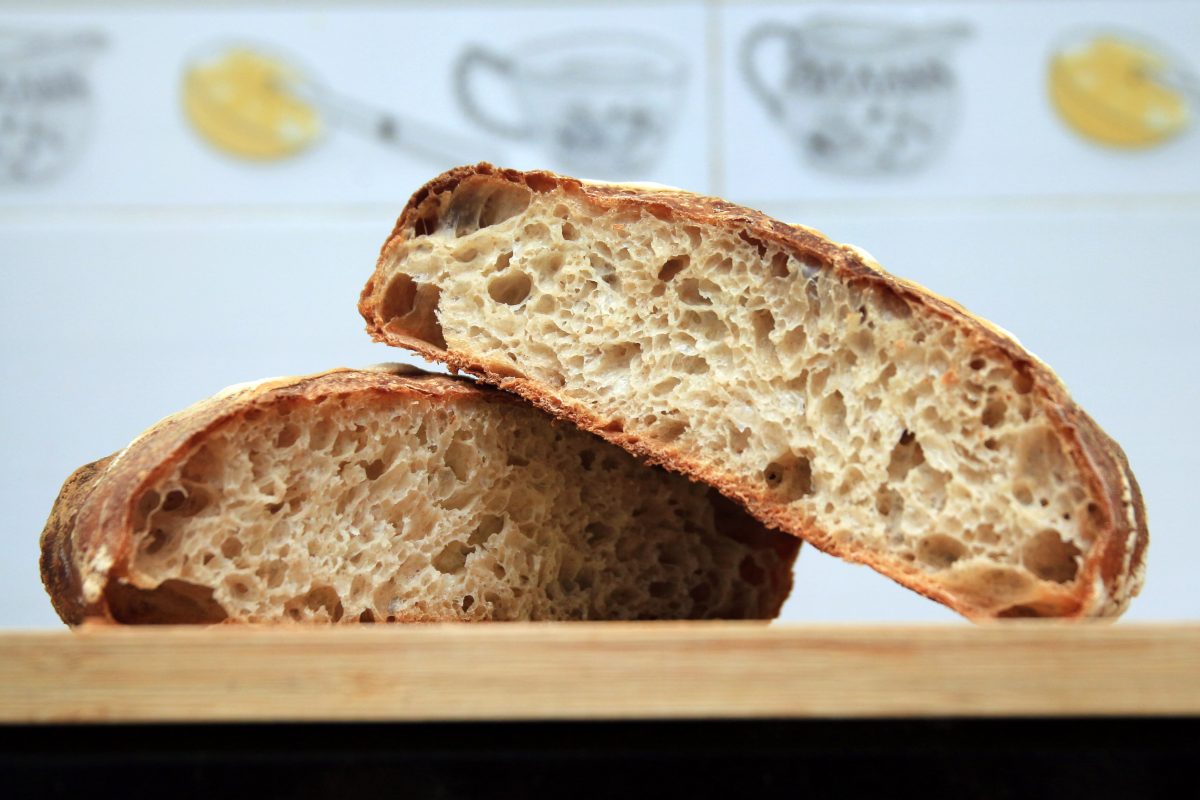
Why Is Sourdough Bread Good for You? Benefits + How to Make Your Own
Jillian Levy, CHHC via Dr. Axe – With sourdough bread perhaps more popular than it’s been in quite some time, do you ever wonder: Why is sourdough bread good for you? It helps to take a look at old-school bread vs. what we’ve become accustomed to buying at the store.
For centuries, bread was made with only three ingredients: flour, water and salt. Today, commercially made breads that you’d find in the grocery store can contain a dozen or more ingredients. It’s not surprising then that a high percentage of people report having difficulty digesting modern-day bread.
The original way to make bread was to slowly ferment flour with water in order to create a “starter,” an alternative to baker’s yeast that makes bread naturally rise and gives sourdough bread its signature taste. Not only does sourdough bread stand out in terms of its flavor, but it’s also thought to have some nutritional advantages too.
Why is sourdough bread good for you? Read on to find out why grain fermentation results in a product that is easier to digest, plus how sourdough bread can provide you with more absorbable nutrients, such as selenium, B vitamins, folateand others.
What Is Sourdough Bread?
Sourdough bread is bread made via the fermentation of dough. Fermentation is defined as “the chemical breakdown of a substance by bacteria, yeasts, or other microorganisms, typically involving effervescence.”
Compared to nearly every other bread, what is different about sourdough bread?
Real sourdough is made with a fermented sourdough starter, rather than with yeast. It also has a lower gluten content, lower antinutrient content and lower pH than regular bread.
Sourdough is also often described as having more flavor and complexity and a better texture than yeasted breads.
When flour and water are left at room temperature for at least several days, naturally occurring bacteria (such as lactobacilli) and yeast begin to ferment the dough and produce lactic acid. Lactic acid is responsible for giving the bread its slightly sour but pleasant taste.
Flour naturally contains a variety of yeasts and bacterial spores. When combined with water at room temperature (somewhere between 65 and 85 degrees Fahrenheit), bacteria break down the starch found in wheat into sugars (glucose and maltose), which yeast then metabolize.
Maltose is one byproduct of the bacterial fermentation that yeast thrive off, and in the process they produce carbon dioxide gas, leavening the dough.
It’s thought that some of the oldest sourdough breads date back to at least 3700 BCE in the Fertile Crescent region, although historians are not exactly sure when people first began fermenting grains. The “Encyclopedia of Food Microbiology” points out that “Bread production relied on the use of sourdough as a leavening agent for most of human history; the use of baker’s yeast as a leavening agent dates back less than 150 years.”
Is sourdough the same as Ezekiel bread?
No, although the two have a number of things in common. Ezekiel bread is a sprouted grain bread that is made with whole grains and usually no yeast.
Sprouting grains helps diminish levels of enzyme inhibitors and releases nutrients to more easily be absorbed, much like fermenting does. However, sourdough bread takes longer to make and usually isn’t made with sprouted flour.
Overall the two are comparable in terms of nutrient content.
Nutrition Facts (Plus Ingredients)
Why is sourdough bread good for you? A lot of it comes from sourdough bread nutrition.
The exact nutrition content of sourdough depends on the exact ingredients used (different types of flours/added grains/oil) and how it’s prepared. Generally, however, it contains a decent amount of:
- calories
- carbohydrates
- protein
- fat
- fiber
- selenium
- folate
- thiamine
- manganese
- niacin
- iron
- wheat bran
- hard red wheat
- oats
- rye
- barley
- spelt
- triticale
- flaxseeds
- apple cider vinegar
- olive oil
- garlic
- honey
- herbs, such as rosemary
- Kazachstania exigua (Saccharomyces exiguous)
- Saccharomyces cerevisiae
- Candida milleri
- Candida humilis
- Lactobacillus sanfranciscensis
- L. pontis
- L. fermentum
- L. fructivorans
- L. brevis
- L. paralimentarius
Why Is Sourdough Bread Good for You?
Research tells us that due to how its unique preparation method, the following are some sourdough bread benefits:
1. May Be Easier to Digest Due to Less Gluten/Antinutrients
There’s reason to believe that among people with gluten sensitivity (but not celiac disease), sourdough bread may be more digestible than commercial loaves made with processed wheat flour.
The fermentation process increases acidic conditions in sourdough and helps produce enzymes that partially break down proteins, including gluten. This leads to a lower overall gluten content and decreased levels of phytates/phytic acid and other “antinutrients” that can interfere with nutrient absorption and digestion.
2. Lower Glycemic Index
Studies have found that whole grain sourdough breads have a somewhat lower glycemic index score compared with other types of bread, especially highly processed breads made with white flour.
Whole grain sourdoughs that are made with whole wheat flour, rye and other grains are recommended for those following a Mediterranean diet, due to their supply of filling dietary fiber.
Is sourdough bread good for weight loss? Of course it depends how much you eat of it, but it can be if it helps to fill you up and is eaten as part of a balanced diet.
In fact, some studies have found that sourdough tends to lead to higher satiety (fullness) compared to other breads, perhaps because of its protein and carbohydrate digestibility and absorption.
3. Can Be a Good Source of Fiber, Nutrients and Protein
Whole grain sourdough is considered a high-fiber food and also a good source of essential nutrients like selenium, folate, thiamine, manganese, niacin and iron. While it can be difficult to absorb some of these nutrients from grains that haven’t been soaked, sprouted or fermented, studies suggest they are typically easier to absorb from sourdough due to the way that it’s prepared, as are the amino acids in sourdough which form proteins.
Acquiring more of these essential nutrients from your diet is important for supporting functions such as red blood cell production, energy metabolism, immune system activation and more.
How to Make Your Own
While it may be faster and easier to make bread using commercial yeast, the old-school way of making sourdough has recently seen a revival among artisan bakers.
How do you make sourdough bread from scratch? First you need to either make or find a sourdough starter.
Recall that sourdough bread recipes do not use yeast, so a starter (or leavening agent) is essential for helping your bread rise and for providing some of its nutritional benefits.
- A starter is also sometimes called a pre-ferment, and it’s made simply by combining flour and water. When left to ferment, it forms into a colony of microorganisms, including wild yeast and lactobacilli. This process usually takes between five to 10 days, depending on the method, temperature and how sour you want the bread to be once cooked.
- To keep your starter “alive” and active, you need to refresh it by adding more flour and water throughout the process. Once the starter is stable you can keep it in your refrigerator and periodically feed it, about one to two times per week.
What’s the best sourdough bread in the world? This is definitely up for debate, as there are dozens of different ways to make sourdough bread — depending on the equipment you have, amount of time you want to invest and how picky you are about the finished product.
One key difference between sourdough recipes is whether or not you knead the bread. Another thing to consider is the schedule you adhere to in order to allow the bread the rise.
Here’s the basic process involved in making your own sourdough bread from scratch:
- You want your starter to be bubbly and active before making bread, so it should be fed four to 12 hours prior to mixing it with flour and water.
- Combine your ingredients thoroughly, and then let the dough sit so it grows in size.
- You may need to knead or shape your dough one to three more times before it’s ready (although no-knead options are also available). Then the dough is formed into a loaf and baked for about an hour.
- For home bakers, baking in a dutch oven is often recommended, usually with the lid on for a period of time to help steam the bread, then the lid off to crisp it.
If you’re a beginner, a simple way to make sourdough from scratch is to choose a mostly no-knead bread recipe and allow it to “bulk rise” overnight. This means that you prepare the ingredients at night, and then the bread rises while you’re sleeping so it’s ready to be baked when you wake up.
If an overnight rise and not much kneading sound appealing to you, try this sourdough bread recipe:
- Combine the flours you are using, such as whole wheat and regular bread flour, with salt. Use about 520 grams of flour and a teaspoon of salt. It’s recommended that you weigh your ingredients for the best results, however 520 grams of flour is roughly equivalent to 4 cups.
- Mix 90 grams of your starter (a bit more than 1/2 cup) with 385 grams water (about 2.25 cups). Then pour the wet ingredients into your bowl with the flour and combine with your hands or a spoon to fully incorporate.
- Let the dough rest 15 minutes. Then stretch it in the bowl a bit. Cover the dough with a damp kitchen bowel and let it rest on the kitchen counter overnight for 9–12 hours ( at 65–70 degrees F).
- After it rests, in the morning, stretch, fold and shape the dough. Let it sit for one more hour and preheat the oven to 450. Either line your dutch oven with parchment paper or sprinkle some cornmeal on the bottom to prevent sticking. (Do not use oil or butter.) Place your loaf in the dutch oven, then “score” the loaf by cutting a big slit on the top that is about one-inch deep and several inches long.
- Keep the lid on for the first 20 minutes, then take the lid off and bake for another 30 to 35 minutes. Allow the bread to cool for an hour, then dig in!
Other Recipes
Looking for other recipes, such as cinnamon raisin sourdough, herbed sourdough or one for making sourdough bread without a dutch oven? Here are some creative ways to make other types of sourdough:
- “Extra Tangy” King Arthur Sourdough Bread
- 3 Ways to Make Amazing Sourdough Bread WITHOUT a Dutch Oven (You can use a baking stone in your oven, an even hotter temperature, or water in a roasting pan to help with steam and crispness.)
- Fifty-Fifty Whole Wheat Sourdough
- Cinnamon Raisin Sourdough Bread
- Roasted Garlic and Rosemary Sourdough Bread
- Whole Wheat Sourdough Tortillas
- Overnight Sourdough Pancakes
What can you make with your sourdough once it’s done? Give some of these healthy recipes a try:
Risks and Side Effects
We’ve answered the question of why is sourdough bread good for you. What about the downsides?
Be cautious about buying sourdough bread from ordinary grocery stores. While supermarkets may advertise bread as “sourdough,” it’s probably “ordinary bread to which as dash of dried powdered sourdough starter has been added,” according to a report written by The Guardian.
Your best option in terms of buying real sourdough is checking out small artisanal bakeries, farmers markets and health food stores.
Even though sourdough can be a healthy addition to your diet, it can still be a relatively calorie-dense food. Therefore keeping portions in check is important, especially if you have a whole loaf fresh out of the oven sitting around your kitchen.
To get the most benefit from healthy breads, try pairing them with a healthy source of fat and protein, which will further lower the glycemic load of the meal and make you feel fuller.
Conclusion
- Sourdough bread is bread made with a fermented sourdough starter, rather than with yeast. The starter is what makes the bread rise, gives it a tangy taste and what contributes to some of its health benefits.
- Why is sourdough bread good for you? Due to the fermentation process, it can be lower in gluten, lower in antinutrients, easier to digest and a good source of several nutrients.
- You can make this type of bread at home using just flour, water and salt. A basic sourdough recipe involves making a starter from scratch (which takes between five to 10 days), then choosing either a kneaded bread or no-knead bread recipe. Once the bread sits out and expands, it’s baked for about an hour in a very hot oven.
To read the original article click here.
For more articles from Dr. Axe click here.






